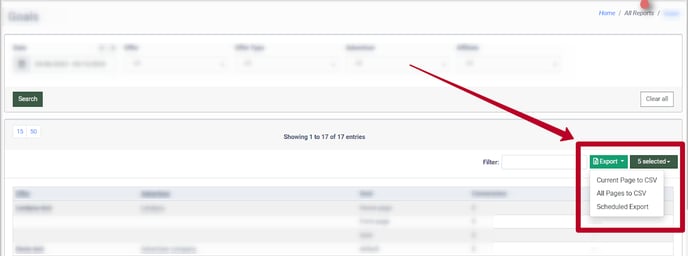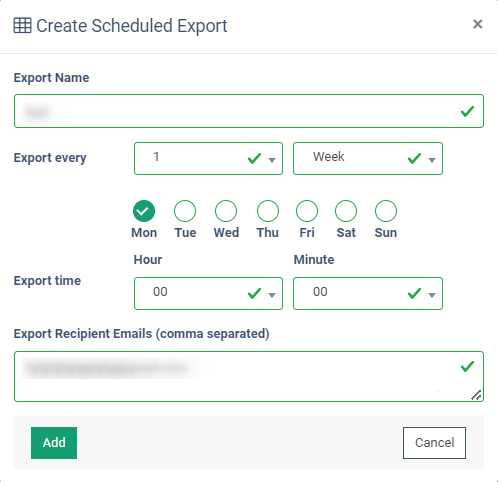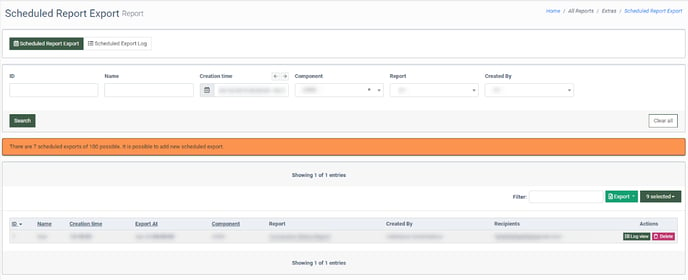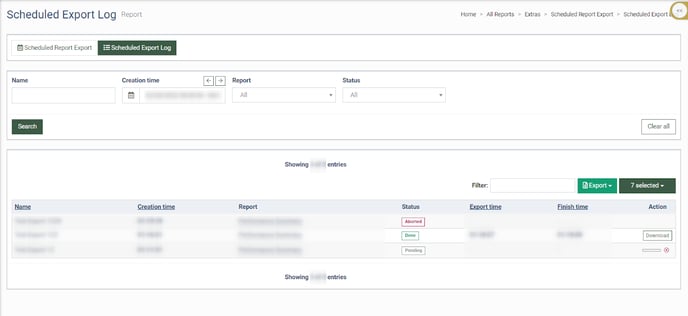Scheduled Report Export (Lynx)
The Scheduled Report Export feature allows you to schedule the report to be sent to a list of specified emails.
You can configure the scheduled export for any report except “Performance Exam” and “Saved reports” reports.
To create a scheduled reporting export request, click the “Export” button on the report page and select the “Scheduled Export” option.

Fill in the following fields in the “Create Scheduled Report” pop-up window:
- Export name: Enter the name for the export.
- Export every: Select the number of weeks or months and the day for the repeat period.
- Export time: Select the time to start the export.
- Export Recipient Emails (comma separated): Enter recipient emails separated by a comma.
Click the “Add” button to complete the action.

To view the list of scheduled report exports and export statuses, click the “Open” button in the “Create Scheduled Report” pop-up window. Alternatively, you can navigate to the All Reports section, go to the All Reports > Extras > Scheduled Report Export section.
Scheduled Report Export Tab
The “Scheduled Report Export” tab displays the list of scheduled report exports.
The list of requests contains the following information:
- ID: The unique identification number of the scheduled report export.
- Name: The name of the scheduled report export.
- Creation time: The date and time of the export request creation.
- Export At: The date and time of the next export.
- Component: The name of the Component.
- Report: The name of the scheduled report.
- Created By: The name of the user who created the export request.
- Recipients: The list of the emails to receive the export.
You can narrow down the search results by using the following filters:
- ID: Enter the unique identification number of the scheduled report request.
- Name: Enter the name of the scheduled report request.
- Creation time: Select the time range of the request creation.
- Component: Select the Component.
- Report: Select the name of the scheduled report.
- Created By: Select the name of the user who created the request.
To view logs for the scheduled reporting, click the “Log View” button in the “Actions” column.
To remove the record from the list, click the “Delete” button in the “Actions” column.

Scheduled Export Log Tab
The “Scheduled Report Log” tab displays the status of the scheduled reporting export.
The report contains the following information:
- Name: The name of the export record.
- Creation time: The day and time of the export creation.
- Report: The name of the scheduled report.
- Status: The status of the current export (Processing, Done, Error, Pending, Aborted, Aborted by Duplicate, Scheduled Reporting Deleted).
- Export time: The day and time when the export started.
- Finish time: The day and time when the export finished.
You can narrow down the search result by using the following filters:
- Name: Enter the name of the scheduled report export.
- Creation time: Select the time range of the export creation.
- Report: Select the name of the scheduled report.
- Status: Select the status of the export (Processing, Done, Error, Pending, Aborted, Aborted by Duplicate, Scheduled Reporting Deleted).

To stop the pending export process, click the “Abort” button in the “Action” column.
To download a file with the executed export, click the “Download” button in the “Action” column.